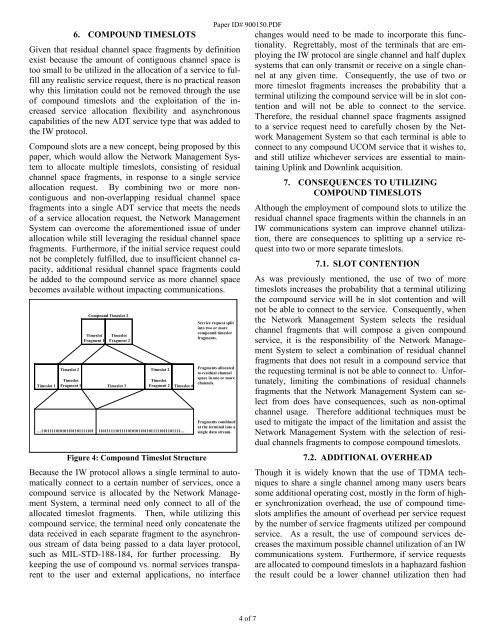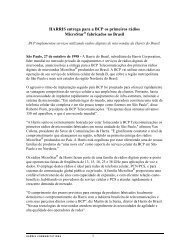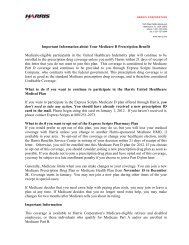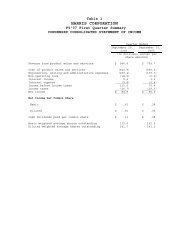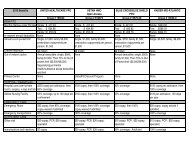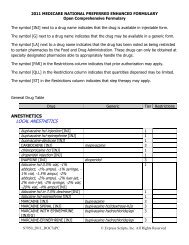METHOD OF ALLOCATING MULTIPLE ASYNCHRONOUS DATA ...
METHOD OF ALLOCATING MULTIPLE ASYNCHRONOUS DATA ...
METHOD OF ALLOCATING MULTIPLE ASYNCHRONOUS DATA ...
Create successful ePaper yourself
Turn your PDF publications into a flip-book with our unique Google optimized e-Paper software.
6. COMPOUND TIMESLOTS<br />
Paper ID# 900150.PDF<br />
changes would need to be made to incorporate this func-<br />
Given that residual channel space fragments by definition<br />
exist because the amount of contiguous channel space is<br />
too small to be utilized in the allocation of a service to fulfill<br />
any realistic service request, there is no practical reason<br />
why this limitation could not be removed through the use<br />
of compound timeslots and the exploitation of the increased<br />
service allocation flexibility and asynchronous<br />
capabilities of the new ADT service type that was added to<br />
the IW protocol.<br />
tionality. Regrettably, most of the terminals that are employing<br />
the IW protocol are single channel and half duplex<br />
systems that can only transmit or receive on a single channel<br />
at any given time. Consequently, the use of two or<br />
more timeslot fragments increases the probability that a<br />
terminal utilizing the compound service will be in slot contention<br />
and will not be able to connect to the service.<br />
Therefore, the residual channel space fragments assigned<br />
to a service request need to carefully chosen by the Network<br />
Management System so that each terminal is able to<br />
Compound slots are a new concept, being proposed by this connect to any compound UCOM service that it wishes to,<br />
paper, which would allow the Network Management Sys- and still utilize whichever services are essential to maintem<br />
to allocate multiple timeslots, consisting of residual taining Uplink and Downlink acquisition.<br />
channel space fragments, in response to a single service<br />
allocation request. By combining two or more noncontiguous<br />
and non-overlapping residual channel space<br />
7. CONSEQUENCES TO UTILIZING<br />
COMPOUND TIMESLOTS<br />
fragments into a single ADT service that meets the needs Although the employment of compound slots to utilize the<br />
of a service allocation request, the Network Management residual channel space fragments within the channels in an<br />
System can overcome the aforementioned issue of under IW communications system can improve channel utiliza-<br />
allocation while still leveraging the residual channel space tion, there are consequences to splitting up a service re-<br />
fragments. Furthermore, if the initial service request could quest into two or more separate timeslots.<br />
not be completely fulfilled, due to insufficient channel capacity,<br />
additional residual channel space fragments could<br />
7.1. SLOT CONTENTION<br />
be added to the compound service as more channel space As was previously mentioned, the use of two of more<br />
becomes available without impacting communications. timeslots increases the probability that a terminal utilizing<br />
the compound service will be in slot contention and will<br />
not be able to connect to the service. Consequently, when<br />
Compound Timeslot 2<br />
Timeslot Timeslot<br />
Fragment 1 Fragment 2<br />
Service request split<br />
into two or more<br />
compound timeslot<br />
fragments.<br />
the Network Management System selects the residual<br />
channel fragments that will compose a given compound<br />
service, it is the responsibility of the Network Management<br />
System to select a combination of residual channel<br />
fragments that does not result in a compound service that<br />
Timeslot 2 Timeslot 2<br />
Fragments allocated<br />
to residual channel the requesting terminal is not be able to connect to. Unfor-<br />
Timeslot 1<br />
Timeslot<br />
Fragment 1 Timeslot 3<br />
Timeslot<br />
Fragment 2 Timeslot 4<br />
space in one or more<br />
channels. tunately, limiting the combinations of residual channels<br />
fragments that the Network Management System can select<br />
from does have consequences, such as non-optimal<br />
channel usage. Therefore additional techniques must be<br />
Fragments combined used to mitigate the impact of the limitation and assist the<br />
…1101111010101101101111101 110111111011110101011011011111011101111…<br />
at the terminal into a<br />
single data stream. Network Management System with the selection of residual<br />
channels fragments to compose compound timeslots.<br />
Figure 4: Compound Timeslot Structure<br />
7.2. ADDITIONAL OVERHEAD<br />
Because the IW protocol allows a single terminal to automatically<br />
connect to a certain number of services, once a<br />
compound service is allocated by the Network Management<br />
System, a terminal need only connect to all of the<br />
allocated timeslot fragments. Then, while utilizing this<br />
compound service, the terminal need only concatenate the<br />
data received in each separate fragment to the asynchronous<br />
stream of data being passed to a data layer protocol,<br />
such as MIL-STD-188-184, for further processing. By<br />
keeping the use of compound vs. normal services transparent<br />
to the user and external applications, no interface<br />
4 of 7<br />
Though it is widely known that the use of TDMA techniques<br />
to share a single channel among many users bears<br />
some additional operating cost, mostly in the form of higher<br />
synchronization overhead, the use of compound timeslots<br />
amplifies the amount of overhead per service request<br />
by the number of service fragments utilized per compound<br />
service. As a result, the use of compound services decreases<br />
the maximum possible channel utilization of an IW<br />
communications system. Furthermore, if service requests<br />
are allocated to compound timeslots in a haphazard fashion<br />
the result could be a lower channel utilization then had


